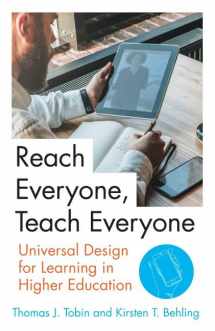
Reach Everyone, Teach Everyone: Universal Design for Learning in Higher Education (Teaching and Learning in Higher Education)
Book details
Summary
Description
Excerpt. © Reprinted by permission. All rights reserved.
Reach Everyone, Teach Everyone
Universal Design for Learning in Higher Education
By Thomas J. Tobin, Kirsten T. Behling West Virginia University PressCopyright © 2018 West Virginia University Press
All rights reserved.
ISBN: 978-1-946684-59-2
Contents
Acknowledgments,
Introduction,
Part 1 Where We Are Now,
1. How Universal Design for Learning Got to Higher Education,
2. It's the Law ... Except When It Isn't,
Part 2 Reframing UDL,
3. Meet the Mobile Learners,
4. Engage Digital Learners,
5. Adopt the Plus-One Approach,
6. Coach the Coaches and the Players,
Part 3 Adopt UDL on Your Campus,
7. Expand One Assignment,
8. Enhance One Program: UDL across the Curriculum,
9. Extend to One Modality: The Online Environment,
10. Embrace One Mind-Set: Campuswide UDL,
11. Engage! The UDL Life Cycle,
Coda,
References,
Index,
About the Authors,
CHAPTER 1
How Universal Design for Learning Got to Higher Education
Meet Kate
Kate Sonka is the academic specialist for the Academic Technology Office in the College of Arts and Letters at Michigan State University, and she is the driving force behind their annual Accessible Learning Conference. We spoke with Sonka in 2017 about how Michigan State created space for accessibility, generally, and for Universal Design for Learning (UDL), in particular. "I came on board with MSU to work on a large project: just reviewing accessibility, understanding what that is for a higher education audience of students, faculty members, and administrators. Up until a few years ago, we talked about accommodations for people with disabilities when we did onboarding for new faculty members, but we didn't have a good way of talking with faculty members about how to be inclusive as a broad practice" (Sonka, 2017).
In our conversation, Sonka revealed that the key to adopting UDL came when she and her colleagues started talking to faculty members, support staffers, and campus leaders in terms of student needs and benefits: "I worked with an undergraduate student who had gotten grant funding to create a series of tutorials about accessibility, and I came to see the value of the student perspective." That student graduated and then joined the MSU team in their central information technology (IT) area. The president and provost soon signed an update to the university's 2009 accessibility policy, explicitly adopting both technical standards for multimedia and a UDL framework for the design of interactions (Michigan State University, 2015). The policy also, importantly, adopts unit-level five-year plans and a purchasing workflow for assessing third-party tools for accessibility. We will explore these ideas in chapters 9 and 10.
For Sonka, UDL principles (which we'll explore in this chapter) served as the framework that allowed everyone on campus to approach accessibility without limiting their perspective solely to disability services. "MSU is all about experiential learning: studying abroad, working in internships. No matter what kind of teaching and research we engage in, there is a place for students in all of that work" (Sonka, 2017). Sonka conceived of a conference to bring together everyone on campus to talk about UDL and accessibility.
Because UDL had been widely adopted in the K–12 world but not yet in higher education, having students themselves advocate for broader access to learning was a winning strategy with the university's senior leaders. "Once we got beyond the echo chamber" of her team, the disability services coordinators, and the central IT staff, Sonka says that "our students helped us to make the case to our president and provost for a one-year experiment to put very different 'buckets' of people together via the conference." The first accessible learning conference (see Michigan State University, 2017) was a response to feedback from students and faculty members about a felt need within the university community, with many people "feeling as though


We would LOVE it if you could help us and other readers by reviewing the book
Book review



